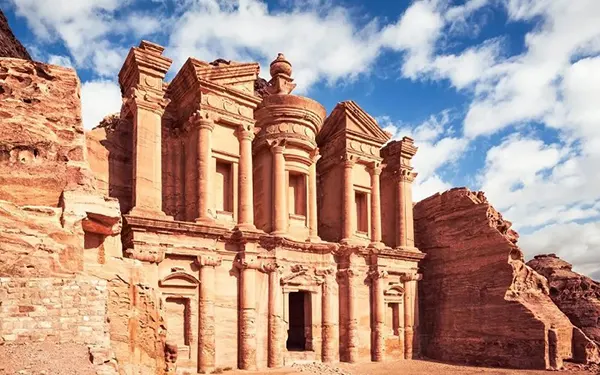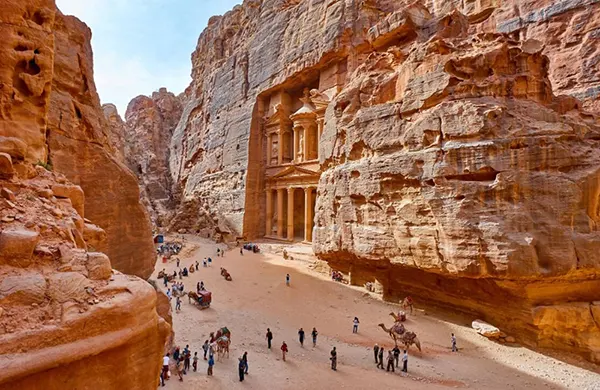Petra (Jordan): The Lost Nabataean Treasure Beneath the Sands

Hidden within the arid deserts of southern Jordan lies Petra, a city hewn directly into rose-red cliffs. Once a vibrant Nabataean capital, it became a forgotten marvel buried under centuries of sand until its rediscovery in the 19th century. Today, Petra is not only a UNESCO World Heritage Site but also a symbol of ancient ingenuity and cultural fusion that continues to intrigue historians, archaeologists, and travellers alike.
The Rise of Petra as a Nabataean Metropolis
The origins of Petra date back to the 4th century BCE when the Nabataeans, a nomadic Arab tribe, settled in the area and transformed it into a thriving commercial hub. Strategically located at the crossroads of major caravan routes, Petra became a crucial centre for trade in incense, spices, and silk between Arabia, Egypt, and the Mediterranean world.
The Nabataeans developed advanced hydraulic systems to combat the harsh desert conditions, including dams, cisterns, and water conduits, enabling agriculture and supporting a large population. Their knowledge of engineering and architecture allowed them to carve monumental facades into sandstone cliffs, blending Hellenistic and local styles in structures such as the Treasury (Al-Khazneh) and the Monastery (Ad-Deir).
By the 1st century CE, Petra reached its zenith under Roman rule, reflecting a harmonious blend of Roman influence and Nabataean culture. However, shifting trade routes and devastating earthquakes led to its gradual decline, and by the 7th century, the city was largely abandoned.
Rediscovery and Archaeological Significance
Petra remained unknown to the Western world for centuries until 1812, when Swiss explorer Johann Ludwig Burckhardt infiltrated the region disguised as an Arab pilgrim. His accounts revealed a forgotten city of immense scale and beauty, reigniting interest in Nabataean heritage.
Subsequent archaeological efforts have uncovered temples, tombs, theatres, and even a sophisticated street grid, providing insights into the city’s urban planning and daily life. Recent discoveries, such as the monumental platform found via satellite imagery in 2016, suggest that much of Petra remains unexplored beneath layers of sand and debris.
Modern technologies including LiDAR, 3D mapping, and drone-based surveys have allowed researchers to document and analyse Petra’s features with unprecedented precision, aiding in both restoration and preservation strategies crucial to combating erosion and tourism-related damage.
The Role of Petra in Regional Identity and Tourism
Petra is more than an archaeological site—it has become a cornerstone of Jordanian national identity. The site is featured on Jordanian currency, stamps, and official emblems, symbolising the nation’s historical depth and cultural pride.
As one of the New Seven Wonders of the World, Petra attracts over a million visitors annually. This influx contributes significantly to the country’s economy, particularly through heritage tourism. However, managing such large-scale visitation poses challenges in terms of site conservation, especially around iconic structures such as the Siq and Treasury.
To mitigate these impacts, Jordanian authorities and international partners have implemented measures such as regulated access, trained local guides, and educational campaigns promoting responsible tourism. These initiatives aim to balance economic benefits with the long-term preservation of Petra’s fragile sandstone structures.
Community Involvement and Cultural Preservation
The local Bedouin communities, particularly the Bdoul tribe, have long-standing ties to Petra. Historically residing in its caves, they played a critical role in protecting and guiding explorers through the city. Today, they are actively engaged in tourism as guides, craftsmen, and performers, enriching the visitor experience with authentic cultural narratives.
Community-led conservation projects and heritage workshops foster local stewardship of Petra’s legacy. For example, traditional masonry skills have been revived to assist in the restoration of collapsing tombs and temples using historically accurate methods and materials.
Furthermore, educational outreach to younger generations ensures that the cultural memory of Petra remains alive, empowering local youth to become ambassadors of their heritage in an increasingly globalised world.

Environmental Challenges and the Future of Petra
Climate change poses a growing threat to Petra’s integrity. Increased rainfall and flash floods can erode sandstone facades and damage fragile infrastructure. In 2022 and 2023, heavy rains triggered closures and emergency interventions to protect tourists and monuments.
Another environmental concern is the impact of mass tourism, particularly vibrations from foot traffic and poor waste management. Conservationists have warned that without sustained effort, Petra’s most iconic features may face irreversible degradation in the coming decades.
To address this, Jordan has partnered with UNESCO and various academic institutions to establish long-term sustainability plans. These include digital archiving of at-risk monuments, environmental monitoring, and visitor management systems aimed at reducing the ecological footprint.
International Cooperation and Digital Preservation
Global institutions such as the Getty Conservation Institute and the Petra National Trust have contributed significantly to safeguarding Petra through research grants, training programmes, and international forums.
Digital initiatives, like the Zamani Project, have created detailed 3D models of Petra’s architecture, allowing virtual tours and educational use worldwide. These tools not only raise awareness but also serve as backups for documentation in case of disaster or loss.
Looking ahead, the integration of local knowledge, scientific research, and international collaboration appears vital to preserving Petra as a living archive of ancient innovation and cultural exchange.
